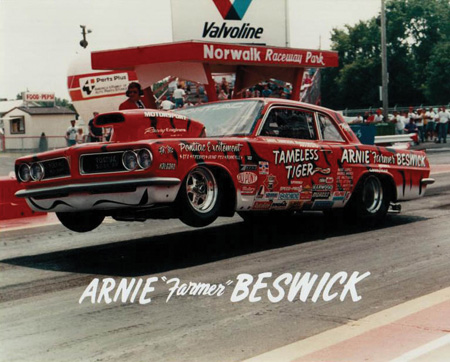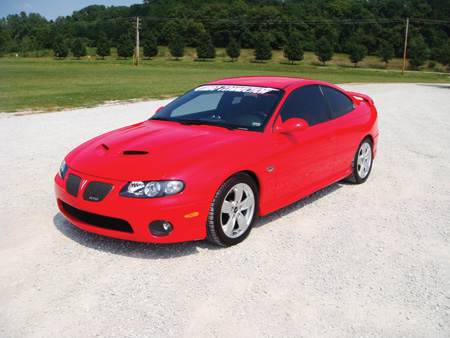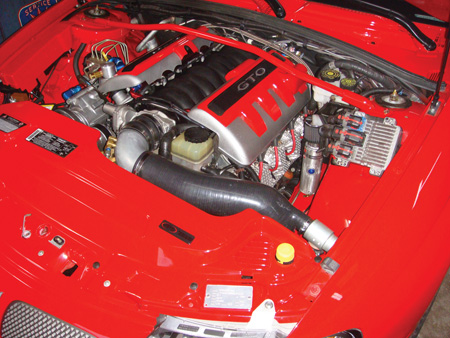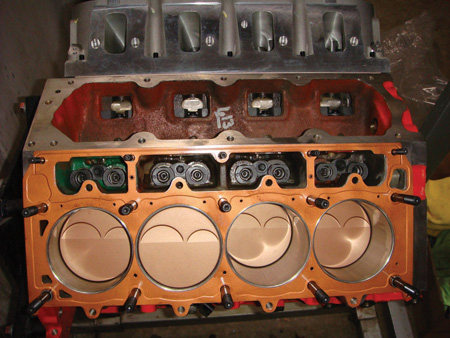Say the name Arnie “Farmer” Beswick and many an old Pontiac fan will nod and share a story or two about Arnie and his legendary GTO, the Tameless Tiger. About two hours down the highway in Illinois, Jim Riskovsky, owner of Turbo Connection in Edwardsville, IL, is learning to tame his own tiger, his 2005 Pontiac GTO.
Jim started out modifying his new 2005 GTO before the factory paint had dried. A supercharger, headers, exhaust, and higher ratio rocker arms pushed the stock shortblock to its limits putting down in excess of 715 horsepower and 625 ft.lbs. of torque. But, when you have a shop named Turbo Connection, you can’t have your shop’s project use a supercharger!
So, with a clean sheet of paper, Riskovsky decided to design a platform that would make a tremendous amount of horsepower, while retaining reliability, drivability, and fuel economy. The goal was to reach 1,000 horsepower at 14-15 pounds of boost while running on race gas, and achieving 850 horsepower on 92 octane pump gas on 10 pounds of boost. Quickly, it was determined that this should be a ground-up design, starting with a solid foundation and building from there.
The Heart of the Beast
The first decision on the design was what block to use. The stock engine in the 2005 GTO is a 364 cid (6.0L) GEN IV V8 that is used in a myriad of GM vehicles from GTOs and Corvettes to various truck platforms. The specifications for the stock engine are shown in Chart 1.
There were immediately two concerns for this new boosted platform. First, the hypereutectic pistons in their stock form would not be reliable under the cylinder pressures at maximum boost levels. A suitable forged piston would be a much more reliable choice. Our second concern was that past tests have shown cylinder liner creep in the stock block configuration when subjected to high boost or high levels of nitrous oxide. Therefore, a cast iron block would be a more suitable choice.
In terms of block availability, the least expensive choice would be to use a GM 6.0L iron block (GM p/n 12572808) commonly known as the LQ9 block which is 3.98? bore, 9.240? deck, 2.56? mains, 6-bolt mains. This block can accept up to a 4.030? bore, and can be purchased new from GM or found in late model trucks in scrap yards. These blocks have proven to be very stable and can be safely stroked to 414 cid with an aftermarket crank.
In March 2007, with the help of Warren “The Professor” Johnson, GM Performance Parts introduced a cast iron, Gen III/IV aftermarket block known as the LSx (GM p/n 19166454). There were many features with this block that made it appealing to our boosted application including the capability to go as large as a 4.25? x 4.50? bore stroke combination, six head bolts per cylinder, priority mains oiling (as opposed to top end priority on the stock block), and the better main caps from the LS7 motor. This made the decision easy, and the LSx block was chosen for the base and a displacement of 427 cid was planned (see Chart 2).
Rotating Assembly
Based on the goal of 1,000 horsepower, Riskovsky had to focus on making a bullet proof bottom end, with the goal of 75,000 miles minimum before a rebuild. The foundation of the rotating assembly is based off of the Eagle Specialty Products 1,500hp kit for the LS series engines. This consists of forged 4340 chromoly crankshaft with 4.000? stroke and 6.125? forged 4340 chromoly H-beam rods with ARP 3.5? bolts.
Flat top JE Pistons were custom designed for this particular turbo application to give a final static compression ratio of 10.7:1, with dual pin oilers and full floating wrist pins. Swain Tech GoldCoat Ceramic Armor Ceramic Thermal Barrier was applied on piston crowns and PC-9 Solid Film Lubricant on the skirts. The ring package consists of Total Seal 2000 Series Gapless Rings, 1/16?, 1/16?, 3mm tool steel top ring, gapless second, and a STD tension oil ring.
The entire block, although it is delivered machined, was deburred, line bored and honed. Calico Coated CL77 rod and main bearings were used. When assembled, clearances were established as follows:
• Rod bearing .025?
• Main bearing .027?
• Wrist pin .0008?
• Upper ring gap .028?
• Second ring .020?
• Piston to wall .006?
Many people questioned the high compression numbers, especially for a turbocharged car. Past builds revealed several things that lend themselves to the goals for this project. First, there is a space limitation for mounting twin turbos on the GTO, and there is limited availability of larger turbos for this application. Second, the camshaft selection for this particular application is mild, which makes it much friendlier in terms of boost.
Along with power, we have found that we can achieve better fuel economy as well as lower exhaust emissions by carefully selecting the compression ratio. Furthermore, this vehicle’s fuel system was redesigned to allow the engine to run on gasoline, E85 or methanol.
Cylinder Heads and Valvetrain
Not since the advent of the legendary “fuelie” head has GM snuck in such a performance head as the L92 cylinder head. The comical thing is that this head is predominantly used on trucks and SUVs! The lineage of the L92 cylinder head can be traced right back to the infamous LS7 cylinder head that is powering the newest Z06 Corvettes. It sports the wider intake ports as compared to the standard LS2 cathedral ports, and has both revised intake and exhaust runners.
If this was back in 1960, we’d be getting these heads out the back door at the GM test facility. Thankfully, the production numbers make these cylinder heads extremely affordable.
For our application, we kept the stock valve size on both the intake (2.165?) and exhaust (1.585?), and CNC ported both ports and decked the heads slightly to achieve phenomenal flow characteristics for a stock casting. Tests have shown that increasing the valve sizes on a bore of 4.125? or less starts to shroud the valve and kill flow.
The stock rocker arms on the intake side (1.7:1 ratio) were kept, while the exhaust rocker arms from the LS7 engine were used (1.8:1 ratio). If you look at the flow ratios, you’ll notice that our ratio has dropped in comparison to the LS1/6/2 cylinder heads. Thus, we can use the higher exhaust rocker ratio to help cheat the airflow a bit.
To match the new port shape of the L92 engine, the stock LS2 intake could not be used. The stock intake that comes with the trucks that are equipped with the L92 cylinder heads is typically too tall for the shorter cowls on GTOs, Corvettes and Camaros. Thus, the L76 intake has to be employed. Although it appears to be identical looking on the outside as the LS2 intake, the ports are developed to optimize the square ports on the L92 heads.
Camshaft
Camshaft choice is probably the number one problem that people run into, and many times, the wound is self-inflicted. As we all know, a camshaft is more than just a Saturday night cruise sound maker; it can make or break an engine for performance, economy and drivability. Too many customers install the biggest camshaft possible without thinking about the engine as a whole.
For this design, Riskovsky chose an off-the-shelf LS7 stock camshaft from the Z06 Corvette. The specs of the camshaft are 211/230 @ .050 120 LSA, .558(1.7)/.588 (1.8). The camshaft was installed at 5 degrees retarded. By installing the camshaft retarded by five degrees, the dynamic compression was dropped from a risky 8.2:1 down to a boost-friendly 7.65:1. This also allowed the shape of the power curve to be shifted higher, which favors this setup due to the fact that it will make gobs of torque down low, but due to the smaller turbos, may run out of breath on the top end.
Feeding the Beast
All this horsepower is created thanks to a pair of APS 20G Garrett 3582 dual ball bearing turbos. The pressure for the turbos is fed through stock exhaust manifolds that were coated with Jet-Hot 2000 series coatings. As tests proved out, these turbos are a bit undersized and are running out of airflow for this engine at upper RPMs. Right now, APS is working on developing a set of larger turbos that will fit this application that should supply an additional 200hp.
Spent exhaust gasses are fed out through a complete stainless steel exhaust system main from Stainless Works for the GTO. Decibel levels are very close to factory levels at idle and while cruising.
The stock fuel system on the GTO was not up to par when trying to support the horsepower levels that this combination puts out. The decision to move the fuel system to a return style system fed by twin 255 lph fuel pumps, connected by eight lines going to a set of aftermarket fuel rails. Attached to these fuel rails are eight 74 pound per hour Mototron high impedance injectors driven by the factory ECM.
Since the car was designed to run on pump gas, two additional alcohol injection kits by SMC Enterprises were installed with the sprayers sending either ethanol or methanol directly into the throttle body. The alcohol system supplements the existing fuel system due to its spraying once in boost. The alcohol fuel curve is tuned by monitoring boost levels and the speed and flow of the pump is regulated accordingly with the controller.
So why choose alcohol as a supplemental fuel? First, alcohol-based fuels typically carry an octane rating from 107 to 115. This extra octane gives our fuel mixture a bit more resistance to detonation, which on a forced-induction vehicle, is very important due to our significant increase in cylinder pressures.
The second and more critical aspect of using alcohol is understanding its effects on the internal combustion engine. The secret lies in the Latent Heat Vaporization and Auto-ignition of alcohols.
If you’ve ever poked around an alcohol fueled engine equipped with carburetors, you probably noticed that the intake runners are iced over during idle, especially if equipped with a large overlap camshaft. Furthermore, while monitoring the engine parameters, you probably noticed that the engine runs quite a bit cooler when using alcohol. What causes this? Well, you’ve probably experienced this phenomenon on a daily basis. Put a bit of water on exposed skin, then gasoline, then alcohol. The alcohol, as it evaporates, will feel the coolest, followed by gasoline, then water. This is all thanks to the Latent Heat Vaporization property of liquids.
Physics dictates that a certain amount of heat is required to convert a liquid to gas. This additional heat is expressed as the Latent Heat Vaporization value. Using the values from Chart 4, ethanol requires about 250 percent of the heat to change to a gas, and methanol requires about 340 percent of the heat. So, in effect, the conversion from liquid to gaseous state will draw heat from the combustion chamber. We know that gasoline will drop the chamber temperature about 40 degrees F, therefore, ethanol will drop the temperature roughly 100 degrees F while methanol will drop it roughly 135 degrees F. Thus, at these Stoichiometric values, we see a significant drop in temperature of the air/fuel mixture.
Notice, too, how much lower the auto-ignition temperature of alcohols are as compared to gasoline. Again, detonation and pre-ignition are the enemy of a forced induction application. By mixing alcohols into the fuel mixture, we are, in effect, helping to raise the auto-ignition temperature of the heterogeneous fuel mixture and adding a significant safety factor to the setup.
Controlling the Beast
The key to taming this tiger is the computer control that GM graced the vehicle with from the factory. For the 2005 GTO, the E40 ECM controls all engine management, and if equipped, a TCM controls the automatic transmission in concert with the ECM. For this application, all of the factory sensors were left in place with the exception of the MAF (mass air flow) sensor. The MAF sensor was removed due to the fact that the increased airflow due to the turbos was “pegging” the meter. In other words, the MAF was not calibrated to see that much airflow and thus we were hitting its ceiling as far as reading.
Inside the GM computers, there is a volumetric efficiency (VE) table specifically tailored to each vehicle setup. Unfortunately, this table doesn’t reflect mechanical VE, but, this table is more of a fueling table based on a combination of air mass, temperature, and pressure.
The VE table is referenced by both RPM and load (MAP). The problem is that without a MAF sensor, the ECM must calculate the airmass. Luckily, we have other sensors that allow us to calculate the airmass, so, GM actually calculates the VE by using the following formula:
VE = gram/cyl*charge temperature/MAP
Thus, by factoring the sensor values from the intake air temperature (IAT), the engine coolant temperature (ECT) and the manifold air pressure (MAP) sensors, as well as the cubic inches of the engine, the ECM will determine the airmass.
Since the basics of the engine have radically changed from the stock configuration, a lot of time is spent within the VE table establishing the new fueling curves. Since we continue to have our stock HEGO (O2) sensors in place, we use the values from them to drive our fueling requirements to a stoich value of 14.7:1.
Unfortunately, there is no magic bullet to derive these values. It is simply done by doing drive cycles either on a load dyno or on the road to balance each cell within the table.
Handling Boost Fueling
The VE fueling table reveals that it stops at 105 KPA, or roughly right at atmospheric pressure. Thus, the stock configuration does not understand boost situations. To remedy this, the stock 1bar MAP sensor is replaced with a genuine GM MAP sensor from a Saturn ION. What this allows is a MAP sensor that has a range up to 2.5bar. Thus, it can read well in excess of the 14 lb of boost that this engine will eventually see.
To allow this new MAP sensor to track, we used HPTuners software to modify the ECM with a custom patch to expand the VE table to accommodate boost. This table, also shown online (Chart 6) now allows the VE fueling calculations to track up to 22+ lbs of boost.
One thing that you will notice is that as we increase boost, we don’t increase fueling that much. This is due to the addition of the alcohol that is added from the SMC kit when under boost. If this kit was not present, then the fueling numbers would continue to grow as demand increased under boost.
We are also able to bias our airmass calculations more towards the IAT readings on a boosted car. This is beneficial if we see that we are experiencing heat soak within the intercoolers, and thus are putting the engine in jeopardy of inducing detonation. By adjusting the bias more towards the IAT, we can ensure that we are reading the increase in air temperature and making adjustments automatically to our fueling calculations.
Controlling Spark
The basic table that controls the spark advance in the ECM is tracked by both engine RPM and cylinder airmass. The benefit of doing the table like this is that since we are using the MAP sensor in calculating our airmass, we will automatically detect boost/non-boost situations. Therefore, without any modifications, the stock tables from the factory are able to handle up to 22 lbs of boost!
Now we can have the best of both worlds; we can have proper timing under non-boost situations to achieve drivability, economy, and emissions considerations, and we can retard timing automatically based on boost levels and rpm. So we don’t have to run any external boost retard boxes.
Furthermore, the default program for the ECM has two timing tables, a high octane and low octane table. Since we still have the factory knock sensors active, we will automatically reduce timing in the event that spark knock is detected, and slowly blend the two timing tables together to achieve a safe condition in real time.
This blending will come into play if you have instances of getting a bad tank of gas, or have other mechanical issues. If the knock situation removes itself, then the ECM will slowly adapt back to running purely off of the high octane tables. Thus, the ECM will constantly be monitoring conditions to ensure that the engine stays together for a long time.
Another timing issue that we have to address is inlet temperatures from the turbo. As we heat soak the intercoolers, we have to be aware of the engine’s tendency to knock under hot aircharge temperatures. Within the ECM is a table that allows us to add or retard timing based on the readings coming from the IAT sensor, which is monitoring our intake air temperature. Another chart you’ll find online (Chart 8) is built from IAT temperature and cylinder airmass, which tracks boost. The table reflects that as our intake temperatures increase, we automatically will reduce timing to ensure that we don’t put the engine into a spark detonation state.
The Results
What Riskovsky has created is blending old school racing technology along with modern day ECM computer controls. The result is an incredibly powerful car under boost situations, yet, a car that is as drivable as it was in its stock form.
Economy and drivability were main goals with this project. To date, the car can consistently bring down 30 mpg on the highway cruising in 6th gear at 70 mph. Thanks to the stock Z06 camshaft, valvetrain longevity and durability is not an issue.
The cam selection also helps to reduce the exhaust noise to near stock levels.
Unless someone was aware of what lurks under the hood, they would never suspect this GTO lays down almost 1000 ft-lbs of torque. The dyno numbers for the current configuration are online, and the graph shows the stock GTO dyno numbers and the latest dyno numbers at 12 pounds of boost. Once the new, larger turbos are delivered, Riskovsky expects another 150hp added to the current numbers.
So, if you are out cruising in Southern Illinois or in the St. Louis area, and you come across a stock looking red GTO, just beware that you may have this tiger by the tail!
Keith McCord is president of McCord Consulting Group in St. Louis, MO. He’s a “gun-for-hire” for various OEM and aftermarket companies to design products, parts, CNC code and process improvement. Keith also writes custom ECMs for GM and Ford vehicles.

















